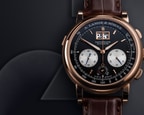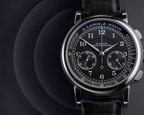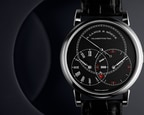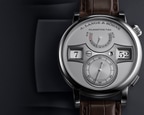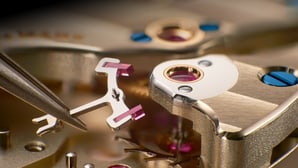A rare complication assuring constant rate accuracy
Often, unusual solutions are required to achieve outstanding results. In accordance with their ambition to never stand still, the A. Lange & Söhne watchmakers continue their quest for new ways to advance the traditional art of watchmaking.
One of the greatest challenges presented is to obtain the highest possible rate accuracy in mechanical watches. With this in mind, complications such as the tourbillon were developed – more than 200 years ago. Watches featuring a constant-force escapement are lesser known and do not boast the same rarity value as tourbillons. This mechanism that also comes under the name of Remontoire d’egalité, delivers a constant amount of energy to the balance of a mechanical watch, regardless of whether it is fully wound or nearly unwound.
How does a constant-force escapement work?
Per definition, the winding spring of a mechanical watch does not supply a constant amount of power. If it is fully wound, it delivers more power than it does towards the end of the power reserve. This has an impact on the precision of the watch: without a compensating device, it would gradually become slower and therefore more inaccurate.
This applies, in particular, to models with an exceptionally large power reserve or a robust winding spring. In watches with a power reserve of two to three days, the difference between the initial and the final torque is negligible, while it considerably affects rate stability in watches with a power reserve of 14 or even 31 days.
A constant-force escapement offers a sophisticated solution to this problem: in short intervals, a pretensioned remontoir spring is marginally retensioned – for example, once a second or once a minute. Within the same time frame, it delivers the absorbed amount of energy to the going train. By retensioning the remontoir spring in such short intervals, its tension is increased only insignificantly, and consequently, declines only marginally within the given interval. Hence, the balance is supplied with a constant force across the entire power-reserve duration of the timepiece.
One complication – three applications: the Lange constant-force mechanisms
The fact that the constant-force escapement was primarily developed to enhance rate accuracy but can perform other tasks as well constitutes one of the most intriguing characteristics of a constant-force escapement. They range from the classic task of assuring constant rate accuracy across a duration of several weeks as in the LANGE 31, or generating the switching impulses for advancing the jumping numerals display in the ZEITWERK models, to controlling the seconds hand in the RICHARD LANGE JUMPING SECONDS.

Like the pounce of a puma
In the ZEITWERK models, the constant-force escapement not only supplies the going train with a steady flow of power, but it also generates the switching impulses needed to advance the jumping numerals. Like a puma preparing to pounce, the constant-force escapement must deliver a strong burst of energy. It is designed to execute a retensioning cycle precisely every 60 seconds. For a brief moment, the full torque of the mainspring barrel is released. Instantaneously, this surge of power is used to switch the numeral discs.
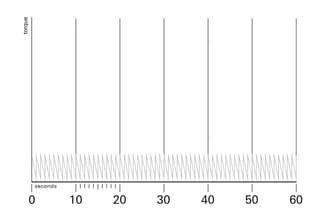
Like a hovering hummingbird
In the RICHARD LANGE JUMPING SECONDS, the constant-force escapement and the jumping seconds mechanism are assigned to separate but firmly interconnected wheel trains. Like a hummingbird, which needs to beat its wings at high frequencies to hover in mid-air, the constant-force escapement must perform many fast-paced switching steps with one-second precision. The mainspring barrel is briefly set free once a second. In the process, it moves the seconds hand forward by one second and incrementally retensions the spring of the constant-force escapement. All the while, the watch runs very precisely thanks to a constant delivery of force.

With the endurance of a marathon runner
With two strong springs, the twin mainspring barrel of the RICHARD LANGE PERPETUAL CALENDAR “Terraluna” provides a power reserve of 14 days.
The LANGE 31 tops this with 31 days. Like a marathoner, this constant-force escapement consumes a considerable amount of energy and – even more importantly – must deliver its power in doses. If fully wound, the torque delivered by this high-energy mainspring barrel would be much too high to be transferred directly to the going train. And if its torque declines when it approaches the unwound state, the accuracy of the watch would deteriorate. To keep the rate of the watch stable for the entire power-reserve period, a patented constant-force escapement is integrated between the twin mainspring barrel and the going train of both watches.
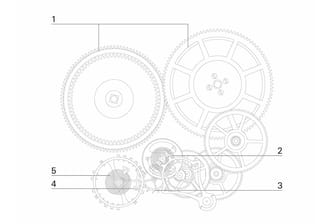
It causes the twin mainspring barrel to produce a small amount of energy every ten seconds. This energy retensions the remontoir spring by an angle of 60 degrees. It corresponds to precisely the amount of energy that it will transmit to the escape wheel, the pallet fork and the balance spring within the next ten seconds. Since the remontoir spring always releases exactly the same amount of energy, the watch is powered with the same torque every day. The result is a constant amplitude and thus an especially high degree of rate accuracy. The remontoir spring of the constant-force escapement and the balance spring are both manufactured in-house and can therefore be optimally paired with the movement.
Complications



Explore further



How can we be of service?
Whether you are in search of a specific model, have questions out of interest or need a service request for your timepiece – we are delighted to help you. We are at your service by phone, email or in one of our boutiques.











